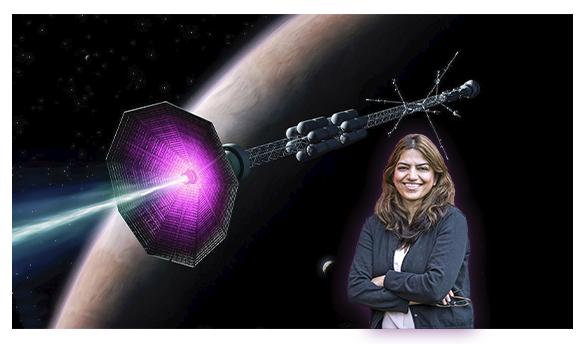
Credit: Elle Starkman (PPPL Office of Communications) and ITER
A new type of rocket thruster that could take humankind to Mars and beyond has been proposed by a physicist at the U.S. Department of Energy’s (DOE) Princeton Plasma Physics Laboratory (PPPL).
The device would apply magnetic fields to cause particles of plasma, electrically charged gas also known as the fourth state of matter, to shoot out the back of a rocket and, because of the conservation of momentum, propel the craft forward. Current space-proven plasma thrusters use electric fields to propel the particles.
The new concept would accelerate the particles using magnetic reconnection, a process found throughout the universe, including the surface of the sun, in which magnetic field lines converge, suddenly separate, and then join together again, producing lots of energy. Reconnection also occurs inside doughnut-shaped fusion devices known as tokamaks.
“I’ve been cooking this concept for a while,” said PPPL Principal Research Physicist Fatima Ebrahimi, the concept’s inventor and author of a paper detailing the idea in the Journal of Plasma Physics. “I had the idea in 2017 while sitting on a deck and thinking about the similarities between a car’s exhaust and the high-velocity exhaust particles created by PPPL’s National Spherical Torus Experiment (NSTX),” the forerunner of the laboratory’s present flagship fusion facility. “During its operation, this tokamak produces magnetic bubbles called plasmoids that move at around 20 kilometers per second, which seemed to me a lot like thrust.”
Fusion, the power that drives the sun and stars, combines light elements in the form of plasma — the hot, charged state of matter composed of free electrons and atomic nuclei that represents 99% of the visible universe — to generate massive amounts of energy. Scientists are seeking to replicate fusion on Earth for a virtually inexhaustible supply of power to generate electricity.
Current plasma thrusters that use electric fields to propel the particles can only produce low specific impulse, or speed. But computer simulations performed on PPPL computers and the National Energy Research Scientific Computing Center, a DOE Office of Science User Facility at Lawrence Berkeley National Laboratory in Berkeley, California, showed that the new plasma thruster concept can generate exhaust with velocities of hundreds of kilometers per second, 10 times faster than those of other thrusters.
That faster velocity at the beginning of a spacecraft’s journey could bring the outer planets within reach of astronauts, Ebrahimi said. “Long-distance travel takes months or years because the specific impulse of chemical rocket engines is very low, so the craft takes a while to get up to speed,” she said. “But if we make thrusters based on magnetic reconnection, then we could conceivably complete long-distance missions in a shorter period of time.”
There are three main differences between Ebrahimi’s thruster concept and other devices. The first is that changing the strength of the magnetic fields can increase or decrease the amount of thrust. “By using more electromagnets and more magnetic fields, you can in effect turn a knob to fine-tune the velocity,” Ebrahimi said.
Second, the new thruster produces movement by ejecting both plasma particles and magnetic bubbles known as plasmoids. The plasmoids add power to the propulsion and no other thruster concept incorporates them.
Third, unlike current thruster concepts that rely on electric fields, the magnetic fields in Ebrahimi’s concept allow the plasma inside the thruster to consist of either heavy or light atoms. This flexibility enables scientists to tailor the amount of thrust for a particular mission. “While other thrusters require heavy gas, made of atoms like xenon, in this concept you can use any type of gas you want,” Ebrahimi said. Scientists might prefer light gas in some cases because the smaller atoms can get moving more quickly.
This concept broadens PPPL’s portfolio of space propulsion research. Other projects include the Hall Thruster Experiment which was started in 1999 by PPPL physicists Yevgeny Raitses and Nathaniel Fisch to investigate the use of plasma particles for moving spacecraft. Raitses and students are also investigating the use of tiny Hall thrusters to give small satellites called CubeSats greater maneuverability as they orbit the Earth.
Ebrahimi stressed that her thruster concept stems directly from her research into fusion energy. “This work was inspired by past fusion work and this is the first time that plasmoids and reconnection have been proposed for space propulsion,” Ebrahimi said. “The next step is building a prototype!”
###
Support for this research came from the DOE Office of Science (Fusion Energy Sciences) and Laboratory Directed Research and Development (LDRD) funds made available through the Office of Science.
PPPL, on Princeton University’s Forrestal Campus in Plainsboro, N.J., is devoted to creating new knowledge about the physics of plasmas — ultra-hot, charged gases — and to developing practical solutions for the creation of fusion energy. The Laboratory is managed by the University for the U.S. Department of Energy’s Office of Science, which is the single largest supporter of basic research in the physical sciences in the United States and is working to address some of the most pressing challenges of our time. For more information, visit https:/
Media Contact
Raphael Rosen
[email protected]
Original Source
https:/
Related Journal Article
http://dx.




